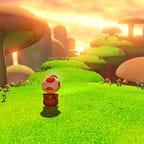‘The Book of Boba Fett’ was a weird entry in the broader Star Wars Universe
The show may have left viewers underwhelmed in some key areas, but its contributions to the larger story are notable
The Book of Boba Fett was a fundamentally weird show. The story was too drawn out in some places, but somehow not fully explained in others. It had some incredible narrative moments, but most of them were centered around another Star Wars character’s story.
The finale of Boba Fett hit most of the high and low points that the rest of the series did. The action scenes were engaging and Din Djarin’s reunion with Grogu was touching. But Boba’s own story still didn’t have the emotional core that I think the writers were aiming for, and it seems that the enduring legacy of this entire series will be as a table setting for the broader story set in the New Republic timeline.
The high points of the Boba Fett are pretty easy to pinpoint and make the entire project worth watching. The chase sequence in episode 2 was excellent — fast-paced action that helped advance the interesting narrative of Boba’s time with the Tuskens. This was perhaps the pinnacle of the Boba-focused episodes (though not, I’d argue, the high point of the entire show).
Likewise, seeing two full episodes devoted to Din and Grogu was an unexpected treat and a nice way to tide viewers over until the (expected) December premier of The Mandalorian’s third season. Deepfake Luke Skywalker is a technological marvel (though more than a little unnerving), and both the Hutt Twins and Krrsantan could be interesting characters in future shows.
Pretty clearly, the best parts of the show were episodes 5 and 6 (which I’ve discussed in a previous post as well). These shows advanced Mandalorian lore, set up future storylines, and answered questions about the remnants of Din’s clan. And while Ashoka’s presence may not have been strictly necessary from a narrative perspective, it was undeniably pretty cool.
Unfortunately, the low points of Boba Fett are also equally easy to spot. I don’t personally mind that large parts of episodes 1–4 were slow-paced (though I know some did), but the narrative stakes of these episodes were often either low or confusing. Boba’s excursions through Mos Espa just didn’t accomplish much, for example. When the big moments happened (like the slaughter of the Tuskens), they often undermined the story that had been building to that point.
Boba Fett is also filled with what feel like missed narrative opportunities. Boba Fett taking over Mos Espa because he wants to give the land back to the Tuskens could have been deeply compelling. But that potential plot line was snuffed out like a candle. Some villain more interesting than the faceless Pykes — or even more storytelling around the criminal syndicate itself — would have been interesting as well. I think the lore of the crime underworld in Star Wars is ripe for more exploration, but the Pykes were just there to provide cannon fodder.
But when I look back on the hours I invested in Boba Fett, I know I enjoyed that time. Even the less compelling episodes — of which there were sadly more than one — were fun in the moment. The Mandalorian convinced me to dive back in Star Wars as a franchise and every installment of live-action or animated Star Wars has become appointment viewing for me (at least, as much as anything on a streaming service can).
So perhaps that’s the greatest value of The Book of Boba Fett — it’s an installment in a steadily-growing universe of Star Wars stories. As a self-contained story, the series left something to be desired. But as the broader franchise chugs full speed ahead into the streaming era, Boba Fett advanced several storylines and deepened the lore for viewers. Calling the show The Mandalorian season 2.5 may be too accurate for the well-being of Boba himself, but it’s an appealing description nonetheless.
Notes:
- I recently read an excellent article by Ben Lindbergh of The Ringer arguing that Star Wars needs to return to movies. I fully agree, though it’s pretty clear that this isn’t likely to happen for at least a couple more years.
- The next Star Wars show is Obi-Wan Kenobi, which I’m sure I’ll have some thoughts on. It would be nice to space out the Tatooine-focused shows, though at least Boba Fett offered viewers a chance to see some other worlds as well.
- Season 2 of The Bad Batch is supposed to come out this spring as well, and there may be more animated projects in the pipeline, too.
The views expressed are mine alone and do not represent the views of my employer or any other person or organization.
